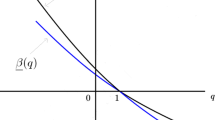Abstract
We know of few explicit results to insure that stationary measures are simultaneously (i) singular, (ii) nonatomic, (iii) with interval support, and (iv) unique. Such results would appear useful, to further separate the analytic notion of singular from the geometric notion of fractal. We prove two general theorems, one for maps of [0,1] into [0, 1], the other for 2×2 random matrices. In each setting, we study measures μ supported on two points of the transformation space, and we provide sufficient conditions to insure that the stationary measures satisfy (i)–(iv).
Similar content being viewed by others
References
Bhattacharya, R. N., and Waymire, E. C. (1990).Stochastic Processes with Applications, John Wiley, New York, pp. 214–215.
Brown, G., Michon, G., and Peyriere, J. (1990). On the multifractal analysis of measures. Preprint.
Chernoff, H. (1952). A measure of asymptotic efficiency for tests of a hypothesis based on the sum of observations.Ann. Math. Statist. 23, 493–507.
Falconer, K. (1990).Fractal Geometry: Mathematical Foundations and Applications, John Wiley, Chichester, Great Britain.
Furstenberg, H. (1963). Noncommuting random products.Trans. Amer. Math. Soc. 108, 377–428.
Furstenberg, H., and Kesten, H. (1960). Products of random matrices.Ann. Math. Statist. 31, 457–469.
Grenander, U. (1963).Probabilities on Algebraic Structures, John Wiley, New York.
Harris, T. E. (1956). The existence of stationary measures for certain Markov processes. Univ. of Calif. Press, Berkeley and Los Angeles,Proc. 3rd Berk. Symp. Math. Statist. Prob. 2, 113–124.
Hutchinson, J. E. (1981). Fractals and self similarity.Indiana Univ. Math. J. 30, 713–747.
Key, E. (1990). Lower bounds for the maximal Lyapunov exponent.J. Theor. Prob. 3, 477–488.
Mandelbrot, B. B. (1977).The Fractal Geometry of Nature, Freeman, New York.
Mukherjea, A., and Nakassis, A. (1977). On the limit of the convolution iterates of a probability measure onn x n stochastic matrices.J. Math. Anal. Appl. 60, 392–397.
Mukherjea, A., and Tserpes, N. (1976).Measures on Topological Semigroups, Lecture Notes in Math. No. 547, Springer-Verlag, Berlin.
Nakassis, A. (1979). Limit behavior of the convolution iterates of a probability measure on a semigroup of matrices.J. Math. Anal. Appl. 70, 337–347.
Okamoto, M. (1958). Some inequalities relating to the partial sum of binomial probabilities.Ann. Inst. Statist. Math. (Tokyo) 10, 29–35.
Peres, Y. (1992). Domains of analytic continuation for the top Lyapunov exponent.Ann. Inst. Henri Poincare 28, 131–148.
Pincus, S. M. (1983). A class of Bernoulli random matrices with continuous singular stationary measures.Ann. Prob. 11, 931–938.
Pincus, S. M. (1985). Strong laws of large numbers for products of random matrices.Trans. Amer. Math. Soc. 287, 65–89.
Rosenblatt, M. (1971).Markov Processes, Structure and Asymptotic Behavior, Springer-Verlag, Berlin.
Sun, T.-C. (1986). Random walks on semigroups. Cohen, J. E., Kesten, H., and Newman, C. M. (eds.),Random Matrices and Their Applications, Contemporary Mathematics, Vol. 50, American Mathematical Society, pp. 221–239.
Author information
Authors and Affiliations
Rights and permissions
About this article
Cite this article
Pincus, S. Singular stationary measures are not always fractal. J Theor Probab 7, 199–208 (1994). https://doi.org/10.1007/BF02213368
Received:
Revised:
Issue Date:
DOI: https://doi.org/10.1007/BF02213368




